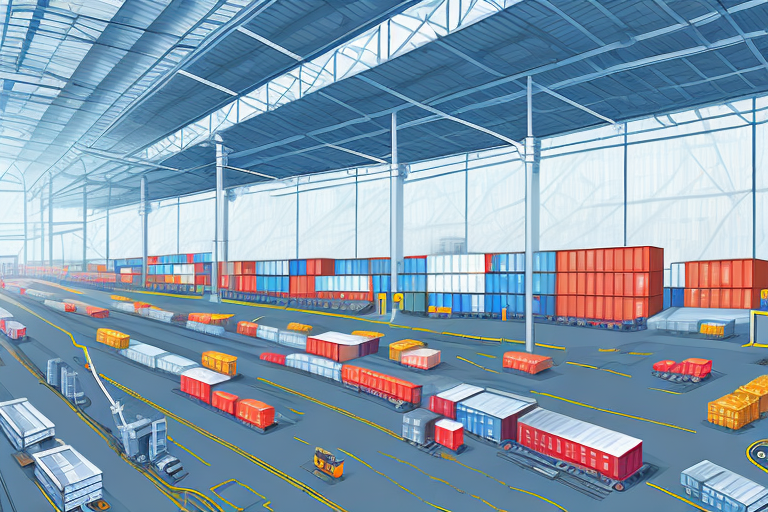The Importance of Location in Industrial Warehousing
In the world of industrial warehousing, location is a critical factor that can make or break a business. The success of a warehouse depends not only on its size and capacity but also on its strategic positioning within the supply chain network. Understanding the role of location in warehousing is essential for businesses to optimize their operations and stay competitive in today’s rapidly evolving market.
Understanding the Role of Location in Warehousing
Before delving into the factors that make location crucial in industrial warehousing, it’s important to define what exactly industrial warehousing entails. Industrial warehousing refers to the storage and management of goods and materials on a large scale, typically for commercial purposes. This sector plays a vital role in supporting various industries, including manufacturing, retail, and logistics.
The connection between location and warehousing becomes evident when we consider the flow of goods within the supply chain. A well-placed warehouse can streamline the movement of products, ensuring efficient delivery to customers and reducing transportation costs.
One key aspect to consider when choosing a warehouse location is proximity to suppliers. Being close to suppliers can significantly reduce lead times, allowing for faster replenishment of inventory. This is particularly important for industries with perishable goods or those that require just-in-time manufacturing processes.
Another factor to consider is proximity to customers. By locating a warehouse near the target market, companies can minimize transportation costs and improve customer service. This is especially crucial for industries with time-sensitive products or those that rely on frequent deliveries to meet customer demands.
Additionally, the accessibility of transportation infrastructure plays a significant role in warehouse location decisions. Warehouses located near major highways, ports, or airports have better connectivity and can easily reach national and international markets. This accessibility not only reduces transportation costs but also enables companies to expand their reach and tap into new markets.
Furthermore, the availability of skilled labor in the chosen location is a critical consideration. A warehouse requires a workforce to handle various tasks, such as inventory management, order fulfillment, and quality control. Choosing a location with a skilled labor pool ensures efficient operations and reduces the need for extensive training programs.
Climate and environmental factors also come into play when selecting a warehouse location. Industries dealing with temperature-sensitive goods, such as pharmaceuticals or food products, need to consider the climate of the chosen location. Extreme temperatures or high humidity can impact the quality and shelf life of these products. Similarly, industries focused on sustainability may opt for locations with renewable energy sources or access to recycling facilities.
Security is another crucial aspect to consider in warehouse location decisions. Warehouses often store valuable inventory, and the risk of theft or damage is a constant concern. Choosing a location with robust security measures, such as gated access, surveillance systems, and on-site security personnel, can help mitigate these risks and protect the company’s assets.
Lastly, the cost of real estate and operational expenses should be factored into the decision-making process. The cost of leasing or purchasing a warehouse space can vary significantly depending on the location. Additionally, operating expenses, such as utilities, taxes, and labor costs, can also vary based on the chosen location. Conducting a thorough cost analysis is essential to ensure that the chosen location aligns with the company’s budget and financial goals.
Factors to Consider When Choosing a Warehouse Location
When selecting a warehouse location, businesses must carefully evaluate several key factors to ensure optimal performance. The decision of where to establish a warehouse can have a significant impact on the overall efficiency and success of a business’s supply chain operations.
Let’s dive deeper into some of the factors that businesses should consider when choosing a warehouse location:
Proximity to Suppliers and Customers
One crucial factor to consider is the proximity to suppliers and customers. Having a warehouse that is located close to suppliers ensures faster access to raw materials and minimizes lead times. This proximity can enhance the efficiency of the procurement process, allowing businesses to quickly replenish their inventory and reduce stockouts.
Similarly, being in close proximity to customers enables faster product delivery, reducing order fulfillment time and enhancing customer satisfaction. With shorter transportation distances, businesses can respond to customer demands more quickly, leading to improved customer loyalty and increased sales.
Moreover, a strategically located warehouse can facilitate just-in-time inventory management, allowing businesses to keep low inventory levels and maximize efficiency. By having a warehouse near both suppliers and customers, businesses can effectively balance their inventory levels and minimize holding costs.
Accessibility and Transportation Links
Accessibility and transportation links are also vital considerations in warehouse location selection. Warehouses that are easily accessible via major roads, highways, and transportation hubs can significantly improve logistics efficiency. They enable faster inbound and outbound shipments, reducing transit times and transportation costs.
Additionally, warehouses located near airports, seaports, or rail terminals enjoy excellent connectivity to global trade routes, enabling businesses to easily import and export goods. This proximity to transportation hubs can streamline international trade operations, allowing businesses to expand their market reach and capitalize on global opportunities.
Furthermore, the availability of reliable transportation infrastructure, such as well-maintained roads and efficient public transportation systems, can contribute to the smooth flow of goods in and out of the warehouse. Businesses should consider the existing transportation infrastructure and evaluate its capacity to handle their expected volume of shipments.
Local Labor Market Conditions
The local labor market conditions are another factor that can impact warehouse location decisions. Access to a pool of skilled and reliable workers is crucial for the smooth operation of a warehouse. Choosing a location with a well-educated workforce and a history of labor stability can minimize recruitment challenges and increase productivity.
Furthermore, assessing the wage rates and labor regulations of a specific area is essential to understand the cost implications of hiring labor in that location. While a location with lower labor costs may seem attractive, businesses should also consider the quality of the workforce and the potential impact on overall operational efficiency.
Moreover, the availability of training and educational institutions in the vicinity can contribute to the continuous development of the workforce, ensuring that employees have the necessary skills to handle warehouse operations effectively.
By carefully considering these factors, businesses can make informed decisions when choosing a warehouse location. Each factor plays a crucial role in optimizing supply chain operations, reducing costs, and enhancing customer satisfaction. Ultimately, the right warehouse location can provide a competitive advantage and contribute to the long-term success of a business.
The Economic Implications of Warehouse Location
Warehouse location decisions also have significant economic implications for businesses.
Cost of Land and Building
One of the primary economic considerations is the cost of land and building. Warehousing requires substantial investment in infrastructure, including land purchase or lease and construction of warehouse facilities. The price of real estate varies depending on the location, and businesses must carefully evaluate the capital expenditure associated with acquiring or building warehouses in different areas.
Additionally, businesses must consider the long-term cost implications, such as property taxes, maintenance expenses, utilities, and insurance.
Tax and Regulatory Considerations
Tax and regulatory considerations can significantly impact the financial viability of a warehouse location. Different regions or countries may have varying tax structures, incentives, and regulations that can affect operating costs and profitability. Businesses should conduct thorough research on tax rates, customs duties, and regulations related to labor, environment, and safety when assessing potential warehouse locations.
The Strategic Value of Location in Warehousing
Aside from the economic aspects, the strategic value of warehouse location should not be underestimated.
Enhancing Supply Chain Efficiency
A well-chosen warehouse location can significantly enhance supply chain efficiency. With the right warehouse placement, businesses can reduce transit times, optimize inventory levels, and minimize order cycle times. These improvements translate into cost savings, smoother operations, and increased customer satisfaction.
Furthermore, strategically positioned warehouses can act as central hubs that consolidate shipments from multiple suppliers and distribute products to various markets. This consolidation and cross-docking approach can streamline the supply chain, reduce transportation costs, and improve overall logistics performance.
Gaining Competitive Advantage
Warehouse location can also confer a competitive advantage. By identifying underserved markets or areas with high customer demand, businesses can strategically position warehouses to ensure superior customer service and fast order fulfillment. This ability to meet customer needs more efficiently than competitors can differentiate businesses and attract a loyal customer base.
Moreover, a strategically located warehouse can help businesses respond rapidly to market changes, such as seasonal demand fluctuations or emerging trends. Flexibility in serving diverse markets can provide a competitive edge, supporting business growth and profitability.
Future Trends in Warehouse Location Selection
As technology and other factors continue to shape the business landscape, warehouse location selection is likely to witness some notable trends.
Impact of Technology and E-commerce
The rise of technology, particularly e-commerce, has revolutionized the logistics industry. With the increasing demand for fast and convenient online shopping, warehouses are adapting to fulfill e-commerce orders efficiently.
As a result, warehouses are increasingly being located closer to urban areas to provide same-day or next-day delivery. This trend is driven by the need to minimize transit times and meet customer expectations in the era of instant gratification.
Sustainability and Environmental Factors
Another emerging trend in warehouse location selection is the consideration of sustainability and environmental factors. Businesses are placing greater emphasis on green operations and reducing their carbon footprint.
Choosing warehouse locations that facilitate eco-friendly practices, such as proximity to renewable energy sources or easy access to public transportation, aligns with sustainability goals. By selecting environmentally conscious locations, businesses can contribute to a greener future while also potentially benefiting from tax incentives or reduced operating costs.
In conclusion, location plays a crucial role in industrial warehousing. The right warehouse placement can optimize supply chain efficiency, reduce costs, and provide strategic advantages. Businesses must thoroughly assess factors such as proximity to suppliers and customers, accessibility, labor market conditions, and economic considerations when selecting warehouse locations. Additionally, businesses should stay attuned to future trends, such as the impact of technology and e-commerce, as well as sustainability and environmental factors, to remain competitive in the evolving warehousing landscape.



